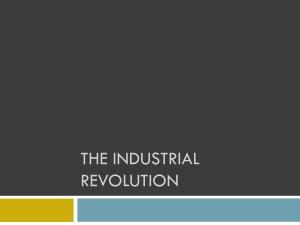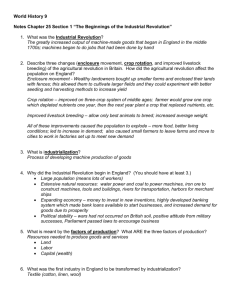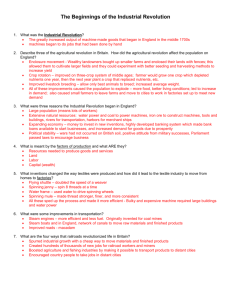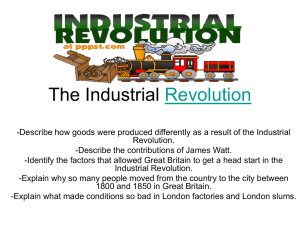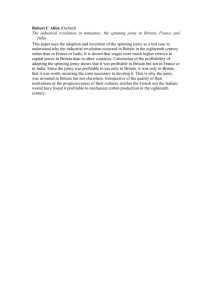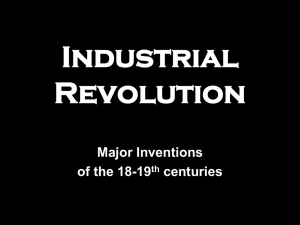1 Pages for British Industrial Revolution
advertisement
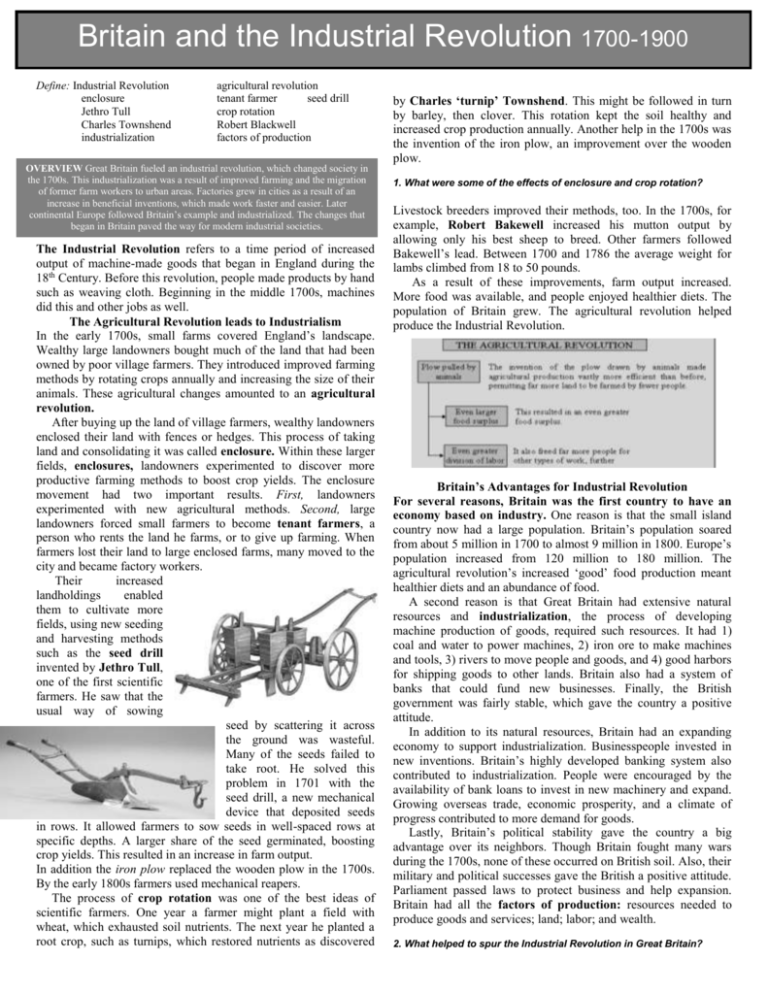
Britain and the Industrial Revolution 1700-1900 Define: Industrial Revolution enclosure Jethro Tull Charles Townshend industrialization agricultural revolution tenant farmer seed drill crop rotation Robert Blackwell factors of production OVERVIEW Great Britain fueled an industrial revolution, which changed society in the 1700s. This industrialization was a result of improved farming and the migration of former farm workers to urban areas. Factories grew in cities as a result of an increase in beneficial inventions, which made work faster and easier. Later continental Europe followed Britain’s example and industrialized. The changes that began in Britain paved the way for modern industrial societies. The Industrial Revolution refers to a time period of increased output of machine-made goods that began in England during the 18th Century. Before this revolution, people made products by hand such as weaving cloth. Beginning in the middle 1700s, machines did this and other jobs as well. The Agricultural Revolution leads to Industrialism In the early 1700s, small farms covered England’s landscape. Wealthy large landowners bought much of the land that had been owned by poor village farmers. They introduced improved farming methods by rotating crops annually and increasing the size of their animals. These agricultural changes amounted to an agricultural revolution. After buying up the land of village farmers, wealthy landowners enclosed their land with fences or hedges. This process of taking land and consolidating it was called enclosure. Within these larger fields, enclosures, landowners experimented to discover more productive farming methods to boost crop yields. The enclosure movement had two important results. First, landowners experimented with new agricultural methods. Second, large landowners forced small farmers to become tenant farmers, a person who rents the land he farms, or to give up farming. When farmers lost their land to large enclosed farms, many moved to the city and became factory workers. Their increased landholdings enabled them to cultivate more fields, using new seeding and harvesting methods such as the seed drill invented by Jethro Tull, one of the first scientific farmers. He saw that the usual way of sowing seed by scattering it across the ground was wasteful. Many of the seeds failed to take root. He solved this problem in 1701 with the seed drill, a new mechanical device that deposited seeds in rows. It allowed farmers to sow seeds in well-spaced rows at specific depths. A larger share of the seed germinated, boosting crop yields. This resulted in an increase in farm output. In addition the iron plow replaced the wooden plow in the 1700s. By the early 1800s farmers used mechanical reapers. The process of crop rotation was one of the best ideas of scientific farmers. One year a farmer might plant a field with wheat, which exhausted soil nutrients. The next year he planted a root crop, such as turnips, which restored nutrients as discovered by Charles ‘turnip’ Townshend. This might be followed in turn by barley, then clover. This rotation kept the soil healthy and increased crop production annually. Another help in the 1700s was the invention of the iron plow, an improvement over the wooden plow. 1. What were some of the effects of enclosure and crop rotation? Livestock breeders improved their methods, too. In the 1700s, for example, Robert Bakewell increased his mutton output by allowing only his best sheep to breed. Other farmers followed Bakewell’s lead. Between 1700 and 1786 the average weight for lambs climbed from 18 to 50 pounds. As a result of these improvements, farm output increased. More food was available, and people enjoyed healthier diets. The population of Britain grew. The agricultural revolution helped produce the Industrial Revolution. Britain’s Advantages for Industrial Revolution For several reasons, Britain was the first country to have an economy based on industry. One reason is that the small island country now had a large population. Britain’s population soared from about 5 million in 1700 to almost 9 million in 1800. Europe’s population increased from 120 million to 180 million. The agricultural revolution’s increased ‘good’ food production meant healthier diets and an abundance of food. A second reason is that Great Britain had extensive natural resources and industrialization, the process of developing machine production of goods, required such resources. It had 1) coal and water to power machines, 2) iron ore to make machines and tools, 3) rivers to move people and goods, and 4) good harbors for shipping goods to other lands. Britain also had a system of banks that could fund new businesses. Finally, the British government was fairly stable, which gave the country a positive attitude. In addition to its natural resources, Britain had an expanding economy to support industrialization. Businesspeople invested in new inventions. Britain’s highly developed banking system also contributed to industrialization. People were encouraged by the availability of bank loans to invest in new machinery and expand. Growing overseas trade, economic prosperity, and a climate of progress contributed to more demand for goods. Lastly, Britain’s political stability gave the country a big advantage over its neighbors. Though Britain fought many wars during the 1700s, none of these occurred on British soil. Also, their military and political successes gave the British a positive attitude. Parliament passed laws to protect business and help expansion. Britain had all the factors of production: resources needed to produce goods and services; land; labor; and wealth. 2. What helped to spur the Industrial Revolution in Great Britain? Turning Point in History: In 1750 most people lived and worked in small farming villages, made their own clothes and grew their own food. By 1850 villages grew into industrial cities. There were more workers in factories than workers on farms. Rural life disappeared. People bought food and clothes. Steam engines on trains and ships encouraged travel. Define: Eli Whitney James Watt cotton gin entrepreneur flying shuttle watt spinning jenny Manufacturing: Textile Mills The Industrial Revolution in Britain was spurred by in technology. This is most obvious in the textile industry. Inventions in the late 1700s transformed cloth manufacturing. These developments had an impact on the world. England’s cotton came from plantations in the American South, where cotton production skyrocketed from 1790 to 1810 in response to demand from the textile mills of England. This demand was aided in 1793 by Eli Whitney’s cotton gin which separated the sticky seeds from the picked cotton plants. The gin cleaned more cotton than done by hand. American cotton production skyrocketed from 1.5 million pounds in 1790 to 85 million pounds in 1810. Slavery also became imbedded in American agricultural life. Britain’s textile industry clothed the world in wool, linen, and cotton. This industry was the first to be transformed. Cloth merchants boosted profits by speeding up the process of spinning and weaving. By 1800, several inventions modernized the cotton industry. In 1733, John Kay made a flying shuttle that sped back and forth on wheels. This boat-shaped piece of wood to which yarn was attached, doubled the work a weaver could do in a day. Spinners could not keep up with the weavers now. So in 1764, James Hargreaves, invented a spinning wheel named spinning jenny, which allowed one spinner to work eight threads at a time. At first, textile workers operated the flying shuttle and the spinning jenny by hand. Then Richard Arkwright invented the water frame in 1769. The machine used the waterpower from rapid streams to drive spinning wheels and jennies. In 1779, Samuel Crompton combined features of the spinning jenny and the water frame to produce the spinning mule. The spinning mule made more thread that was stronger, finer, and consistent. Run by waterpower, Edmund Cartwright’s power loom sped up weaving after its invention in 1787. The water frame, spinning mule, and power loom were bulky, expensive machines. So spinning and weaving moved out of the house and into large buildings called factories, built close to rivers, which provided a source of energy. These factories were built to house all spinning and weaving machines in the textile industry and to keep the processes secret. These machines helped Britain to become a world producer of cotton. In 1785 40 million yards were produced. By 1850, England produced 2 billion yards ! water frame spinning mule power loom factories However in 1789 an Englishman, Samuel Slater, immigrated to the US. Little did his former employers at the Strutt Cotton Mill in Derbyshire know that Slater memorized the spinning machines and water frames which he duplicated in Pawtucket, Rhode Island in 1790. Slater’s Mill was the first successful water-powered spinning mill in the US. Slater became known as the "Father of the American Factory System" and America went ahead of Britain in cotton production by the mid-1800s. 3. What were the major inventions in the textile industry? Improvements in Transportation Textile industry progress spurred other innovations. The first, a steam engine, started from the need for a cheap source of power. The earliest steam engine was used in mining in 1705. But this early model used great quantities of fuel, making it too expensive. In 1712, Thomas Newcomen invented a steam engine powered by coal. It was used to pump water out of British coal mines. Then in 1764, James Watt, a Scottish mathematical instrument maker, tried to repair a Newcomen engine and ended up inventing a better one. His engine stopped steam loss to make it more efficient. In 1769, Watt patented his steam engine, which worked faster while burning less fuel. In 1774, Watt joined an English entrepreneur, Matthew Boulton, who organized, managed, and put up capital, money, for their new business. While Boulton took all the risks, he paid Watt to build better engines. The measure of mechanical and electrical power, a watt, is named for James Watt. He used horses to describe the power of his engine. He found that a horse could lift 550 pounds of coal 10 feet high in 10 seconds or 33,000 pounds per foot per minute. Thus the power of engines is measured in ‘horsepower.’ Today an SUV has a 200 horsepower engine. In comparison, a light bulb, measured in watts is anywhere from 40 to 250 watts. One horsepower equals 745.56 watts…now that’s power! Water Transportation Steam could also be used to propel boats. American inventor, Robert Fulton, bought a steam engine from Boulton and Watt. In 1807 Fulton’s steamboat, the Clermont, successfully ferried passengers along New York’s Hudson River. In England, water transportation improved with the creation of a network of canals, or human-made waterways. By the mid-1800s, 4,250 miles of inland channels slashed the cost of transporting raw materials. Road Transportation British roads improved. In the early 1800s John McAdam, a Scottish engineer equipped roadbeds with layers of stones for drainage. On top was a smoothed layer of crushed rock. Now even in rainy weather wagons could travel over the new “macadam” roads without sinking in mud. Private investors formed companies that built roads and then operated them for profit. People called the new roads turnpikes because travelers had to stop at tollgates to pay a toll What did you learn? Identify the causes of the Industrial Revolution in Great Britain. What effect did this revolution have on America?
